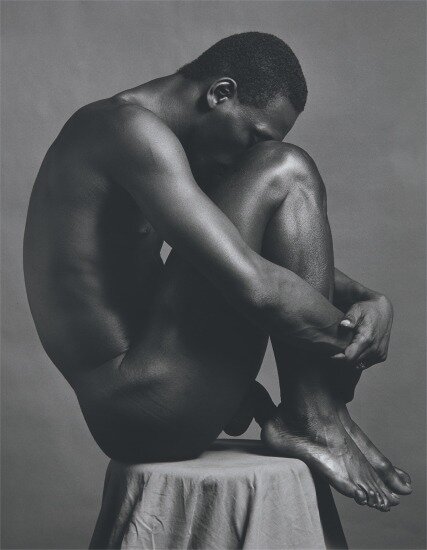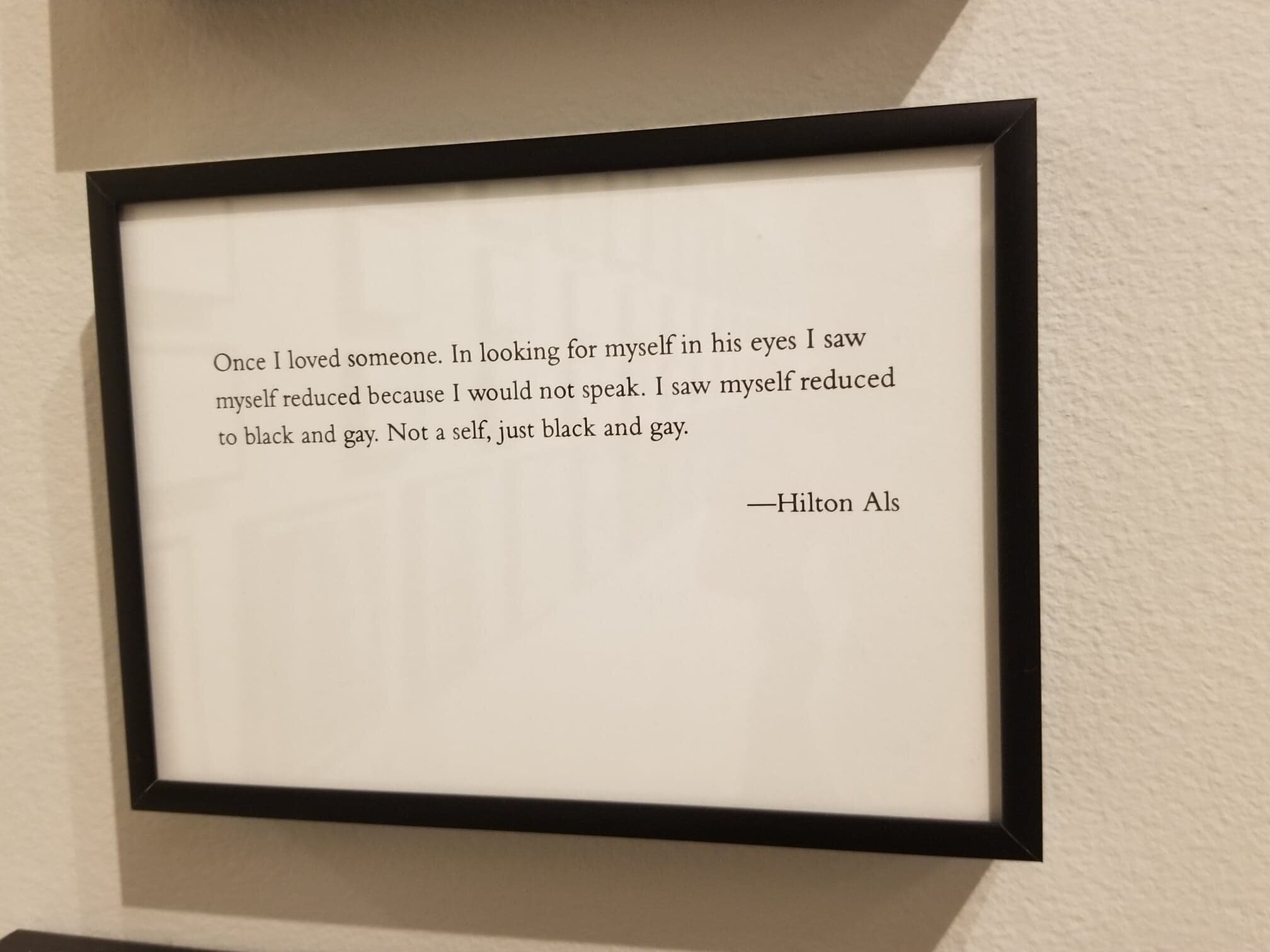Introduction
In 1986, Robert Mapplethorpe published The Black Book, a selection of idealized and nude photographs of men of the African diaspora. The Black Book supposedly centers an astonishing photographic study of African and African American men "today". The book incited a range of responses, creating somewhat of a moral outrage. Glenn Ligon, a conceptual artist of the 90s, too, responded to the book in a notable way.
In this series of contextual artworks, we will explore Glenn Ligons’ rebuttal to Robert Mapplethorpe, The Black Book. Entitled, Notes on the Margin of the Black Book; this masterful collection of images and assorted quotes by Ligon highlights African and African American masculinity and African and African American Identity through the usage of contextual images coupled with quotes from activists and critics of Mapplethrope. Foregrounding race and sexuality, Ligon’s work is primarily concerned with the construction of African and African American identity as it is articulated through words and images. A few house keeping before we get started.
WARNING: As a preface, some of the images depicted may contain nudity or sexual content and is intended for a mature audience. Please proceed gently.
Robert Mapplethorpe
The Black Book
Robert Michael Mapplethorpe was an American photographer, best known for his black-and-white photographs. Mapplethorpe worked primarily in a studio, and almost exclusively in black and white, with the exception of some of his later work and his final exhibit "New Colors". His body of work features a wide range of subjects. He exhibited a great mastery on how to appreciate a little difference between a spectrum of dark and light gray’s.
The Black Book, first published in 1986, presents 96 formally stringent and highly erotic nudes, all of them photographs of men of the African diaspora, either as full figures, or staged as details, as fragments of their bodies.
Mapplethorpe's subject matter is portraits, still lifes, nudes and landscapes. His technical ability is flawless and takes the black-and-white photo to its limit, using subtle, but dramatic, lighting to create weighty sculptural forms. The Black Book, Mapplethorpe s homage to the African and African American male body, is one of the most important visual contributions to the discussion on beauty, sensuality, and sexuality in photography.
ARTIST: Robert Mapplethorpe 1960, New York
SUBJECT: Phillip Prioleau
TITLE: The Black Book
DATE: 1960
PUBLISHER: Schirmer/Mosel; Bilingual edition (March 15, 2010)
ISBN-10: 3829604602
MEDIUM: Offset prints and text
HARDCOVER: 108 pages
Glenn Ligon
Notes on the Margin of the Black Book
Conceptual artist Glenn Ligon appropriates text and images, transforming them into works that ways how race and sexuality shape the visual field. Born out of New York City in the 60s, Ligon pursues an incisive exploration of American history, literature, and society across a body of work that builds critically on the legacies of modern painting and photography.
In taking a look at Robert Mapplethorpes’, The Black Book, Ligon realized that he wanted to sort out the effect of these images of African and African American masculinity had on him as well as on others. He conceived of Notes on the Margin of the Black Book (1991–93).
Created in the years after Robert Mapplethorpe’s death, Notes on the Margin of the Black Book (1991-93) presents framed pages excised from a copy of The Black Book (1986), a volume of Mapplethorpe’s photographs of African and African American men that has been criticized for objectifying and fetishizing its subjects. Interspersed between the photos in Ligon’s installation are quotations from philosophers, activists, curators, historians, religious evangelists, and individuals concerned with censorship issues. Quotes from these evangelista’s—including Audre Lorde, James Baldwin, Greg Tate, Franz Fanon, Isaac Julien and many others—generate a rich sense of context and nuance that offers a framework for the remainder of the works on view.
Ligon arranged the texts so that instead of neatly aligning with the photographs, they punctuate them. This chorus of context immerses the viewer in multiple perspectives, making the dialogues related to Mapplethorpe’s work as visible as the reproductions of his images.
Notes on the Margin of the Black Book, currently published in the Guggenheim museum in New York City, was a disentanglement of questioning and rhetoric of the complex nature of Robert Mapplethorpe.
ARTIST: Glenn Ligonb. 1960, New York
TITLE: Notes on the Margin of the Black Book
DATE: 1991–93
MEDIUM: Offset prints and text
DIMENSIONS: 91 offset prints, framed: 11 1/2 x 11 1/2 inches (29.2 x 29.2 cm) each; 78 text pages, framed: 5 1/4 x 7 1/4 inches (13.3 x 18.4 cm) each
Juxtaposition
The landscape of Black and White photography predates as early as the 19th century. Robert Mapplethorpe uses photography to cast human form onto a white canvas using light and form manipulation. Glenn Ligon takes the casted imagery and displays them in achronological order complimented with quotes by relevant factions of that time.
One might question the relevancy of highlighting Glenn Ligons interpretation of The Black Book over Robert Mapplethorpe himself. Ligons’ adaptation fills in the gaps where Mapplethorpe falls short. Mapplethorpe is seemingly disconnected from the stories of the individuals being photographed in The Black Book. He captures hypersexual African and African American bodies and cast them onto white canvas’s. Although beautiful, the photos do not capture the emotional state of African and African American people of that time period. Ligon interspersed quotes, presents insight into African and African American thought.
Depicted below is visual showcase and analysis of Glen Ligon, Notes on the Margin of the Black Book.
PArt 1:
Images
Part 2:
Words
As we can see, the arrangement of images and quotes take no particular form. Meaning the quotes do not coincide with any individual image but rather can be matched to an image in a remarkable set of ways.
Now, lets conceptualize what an artist statement matched to a photograph would bear to resemble.
(Figure 1.)
ARTIST: Robert Mapplethorpe 1960, New York
TITLE: The Black Book
DATE: 1960
One is no longer aware of the Negro, but only of a penis: the Negro is eclipsed. He is turned into a penis. He is a penis.
—Frantz Fanon
(Figure 2.)
ARTIST: Robert Mapplethorpe 1960, New York
TITLE: The Black Book
DATE: 1960
“The naked Black men characterized by Mapplethorpe engage a certain racist romanticism of Black men's excessive physicality and sexual readiness, their photographic currency as a sexual sign. Perhaps the most offensive dimension of Mapplethorpe's work, it is never that which is explicitly named as the offensive by Helms; the fear of miscegenation operates tacitly here as well, daisavowed, contained, and deferred by the stated spectre of ''homoeroticism” or the general possibility of ''individuals engaged in sex acts.”
—Judith Butler
(Figure 3.)
ARTIST: Robert Mapplethorpe 1960, New York
TITLE: The Black Book
DATE: 1960
You’re kind of killing the “great white father” with this project, arent you?
—Thomas Allen Harris
Conceptual Analysis
As mentioned previously, Ligons’ adaptation fills in the gaps where Mapplethorpe falls short. Taking a look at figure 1, we see an image of a man holding a gun, in parallel to an erect penis. Next to the image, we see a quote by Frantz Fanon with the caption “One is no longer aware of the Negro, but only of a penis: the Negro is eclipsed. He is turned into a penis. He is a penis.” It becomes important to note that Frantz Fanon was a French West Indian psychiatrist and political philosopher, whose works are influential in the fields of post-colonial studies, critical theory and Marxism. Fanon is most famous for his book, The Wretched of the Earth, which discusses western colonialism in the context of race, culture, and historical relevancy. This notable figure in American history critiques Mapplethorpe imagery in a way that foreshadows his own experiences. This allows the audience a peak into the mind of an African American leader during a decade of renaissance.
From the meticulous selection of quotes and arrangement of photos, we can note that Ligon neither condemns the photographs as fundamentally racist, nor does he defend them from criticism. Instead, “Notes on the Margin of the Black Book” demonstrates that images can be both sensual and repulsive, the object of simultaneous desire and disdain. The usage of both text and image attempts to create a coherent theme of sexual objectification but fails to command a unified response. The pieces exist both separately and in joint.
For me, race is far removed in the context of the collection, as it exists in a social construct. Mapplethorpe puts “Black” and “Brown” bodies on display to be consumed and admired while Ligon upholds the structure of race, posed as a marker to ones identity. Both artist approach African and American bodies in a similar lens. They view race as the center of identity when its original context was less about lineage or phenotype and more of an indicator to class and structure. The lack of cultural affliation is my one critique of the collection
Feel free to conceptualize your own analysis by matching a photo to an image.
Conclusion
I first came across Ligons’, Notes on the Margin of the Black Book on a visit to New York over the summer of 2019 at the Guggenheim Museum. I was in awe to see the ebbs and flow of such sensual and taboo imagery casted from film and onto a gala. Coupled with quotes from a few of my favorite writers and poets, the aura of this arrangement was forever etched into my brain. The vibrations of Ligons work caught the attention of many in the room. Some, patiently waiting for others to depart as people lined in formation to fully take in the photos and words on display. This allowed me to fully analyze Ligons’ approach to beauty, form, and representation. Ligon disrupts the means of representation, both pictorially and linguistically. Ligon calls attention to the joint collection, forcing us to consider how they operate with one another.
References
https://hyperallergic.com/23800/glenn-ligon-whitney/
https://www.guggenheim.org/artwork/10382
http://www.glennligonstudio.com/notes-on-the-margin
http://www.mapplethorpe.org/biography/
























